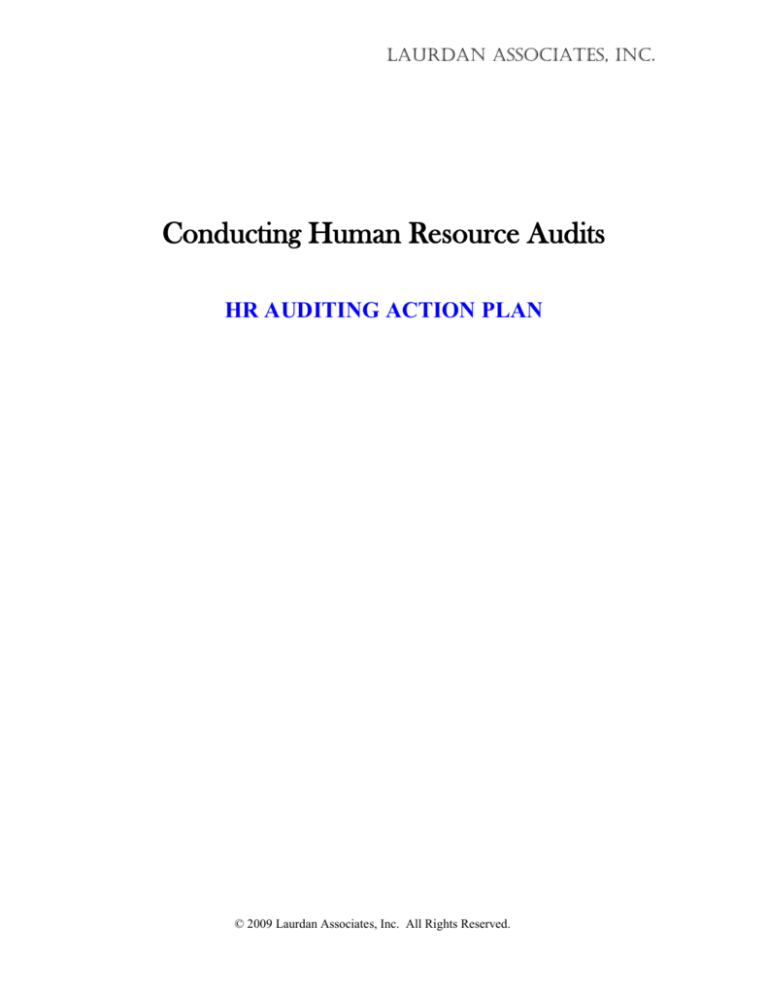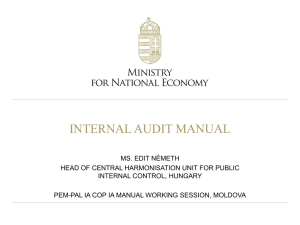
Laurdan Associates, Inc.
Conducting Human Resource Audits
HR AUDITING ACTION PLAN
© 2009 Laurdan Associates, Inc. All Rights Reserved.
Laurdan Associates, Inc.
HR AUDITING ACTION PLAN
Initial Activities:
1. Determine the purpose and objectives of the audit. Why are you conducting
an HR audit?
→ To identify HR management strengths and weaknesses
→ To ensure legal and policy compliance
→ In response to a discrimination charge or employment related
lawsuit
→ To purchase Employment Practices Liability Insurance (EPLI)
→ As a part of crisis management activities
→To collect data and develop measurement standards to benchmark
best practices
→ As a part of regular internal audit procedures
→ As a part of regular risk management procedures
→ As a part of M&A activities
→ Other reasons
2.
\
Determine the scope of the audit. What issues and areas will be audited?
→ The outcomes of current HR management and employment
practices
→ All issues and areas that affect HR management and the
organization’s human capital
→ Specific HR management and employment issues
→ Legal and policy compliance related issues
→ Issues directed by the organization’s attorneys
→ Areas identified by your EPLI carrier
→ Areas performed by vendors and third parties
→ Other areas and issues
3. Determine the organizational components to be audited. Who will be audited?
→ The organization as a single employing unit
→ Subsidiaries and divisions
→ Individual plants, stores, and offices
→ Departments, product lines, profit centers, and cost centers
→ Acquisitions
→ Suppliers, vendors, and third parties
→ Others
© 2009 Laurdan Associates, Inc. All Rights Reserved.
1
Laurdan Associates, Inc.
HR AUDITING ACTION PLAN
4. Determine who will conduct the audit. Who will be part of the audit team?
Who will be audit team leader?
→ The HR Department
→ Your CFO or auditing department
→ Internal or external auditors
→ Your general counsel and/or employment attorney
→ Your risk manager
→ An HR consultant
→ Other
5.
Determine the auditing tool to be used:
→ The Employment-Labor Law Audit™ (ELLA®)
→ A law firm’s check list
→ An internally developed audit
6. Determine costs and resources needed to perform the audit. Consider:
→ The costs associated with purchasing an auditing tool vs.
developing an internal audit tool.
→ Staff salaries and expenses related to conducting the audit, analyzing
the audit findings, reporting the audit findings, and implementing
corrective action.
→ Any legal and HR consulting expertise and expenses associated with
conducting the audit, analyzing the audit findings, and implementing
corrective action.
→ Any computer related costs associated with conducting the audit,
analyzing the audit findings, and implementing corrective action.
→ The clerical and other costs associated with conducting the audit,
analyzing the audit findings, reporting the audit findings, and
implementing corrective action.
→ Overhead and other costs and resources associated with conducting the
audit, analyzing the audit findings, reporting the audit findings, and
implementing corrective action.
7. Determine audit team governance. Consider:
→ How often will the team meet
→ Whether the team will issue interim reports
→ How will audit data and information be collected and stored
→ Who will have access to this data and information
→ Who will receive interim and final reports
© 2009 Laurdan Associates, Inc. All Rights Reserved.
2
Laurdan Associates, Inc.
HR AUDITING ACTION PLAN
→ Whether the auditing findings be reported to employees
→ Who will be the spokesperson for the audit team
→ Who will be responsible for implementing corrective measurers
→ Other governance issues
The Auditing (Assessment) Process:
1. General Comments: Always assume that the findings of your HR audit or
assessments:
→ Will be discoverable
→ Will eventually become common knowledge (there are very
few secrets in most organizations)
→ Will raise employees’ expectations that you will address the
issues identified
→ Will have a negative impact on employee relations if you do not
share the audit findings. NOTE: This is particularly true of
employee surveys
2. Identify key organizational metrics. Organizations measure what they
treasure. To understand what is important, identify what organizational issues,
e.g., total revenue, profitability, work force diversity, or turnover, are being
measured, monitored, and assessed.
3. Determine employment issues accountability. That is, what employment issues
are considered important enough that a manager’s performance affects his/her
compensation?
Once the Audit Has Been Completed
1. As a general rule, prepare a written report of your findings
NOTE: If the audit was performed at the direction of counsel, follow counsel’s
directions about what information should be put in writing and how such
information should be organized
2. Quantify your results ─ Start with outcomes
3. Include an executive summary
4. Identify risks
5. Identify and prioritize solutions to problems identify. Where possible, frame
your solutions from a bottom line perspective, i.e., calculate the benefits and
costs of proposed solutions
6. Evaluate and discuss the organizational, financial, and employee relations
impact of action or inaction
© 2009 Laurdan Associates, Inc. All Rights Reserved.
3









